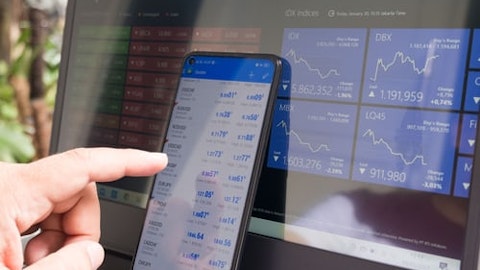PennantPark Investment Corporation (NASDAQ:PNNT) Q1 2023 Earnings Call Transcript February 9, 2023
Operator: Good afternoon and welcome to the PennantPark Investment Corporation’s First Fiscal Quarter 2023 Earnings Conference Call. Today’s conference is being recorded. At this time all participants have been placed in a listen-only mode. The call will be open for question-and-answer session following speakers’ remarks. . It is now my pleasure to turn the call over to Mr. Art Penn, Chairman and Chief Executive Officer of PennantPark Investment Corporation. Mr. Penn, you may begin your conference.
Art Penn : Good afternoon, everyone. I’d like to welcome you to PennantPark Investment Corporation’s first fiscal quarter 2023 earnings conference call. I’m joined today by Rick Allorto, our Chief Financial Officer. Rick, please start off by disclosing some general conference call information and include a discussion about forward-looking statements.
Rick Allorto : Thank you, Art. I’d like to remind everyone that today’s call is being recorded. Please note that this call is the property of PennantPark Investment Corporation and that any unauthorized broadcast of this call in any form is strictly prohibited. An audio replay of the call will be available on our website. I’d also like to call your attention to the customary Safe Harbor disclosure in our press release regarding forward-looking information. Today’s conference call may also include forward-looking statements and projections. And we ask that you refer to our most recent filings with the SEC for important factors that could cause actual results to differ materially from these projections. We do not undertake to update our forward-looking statements unless required by law.
To obtain copies of our latest SEC filings, please visit our website at PennantPark Investment Corporation or call us at 212-905-1000. At this time, I’d like to turn the call back to our Chairman and Chief Executive Officer, Art Penn.
Art Penn : Thanks, Rick. We’re going to spend a few minutes and comment on our target market environment, provide a summary of how we fared in the quarter ended December 31. How the portfolio’s position for the upcoming quarters, our capital structure and liquidity, a detailed review of the financials, then open it up for Q&A. The results were mixed for the quarter ended December 31. However, PNNT is now well positioned to be a more stable, higher earning and higher dividend paying BDC. We saw significant reduction of NAV, primarily due to fair value adjustments to RAM Energy and the publicly traded stock of Cano. Additionally, our NII was reduced by $0.02 per share, due to an increased accrual for excise taxes resulting from overearning our dividend in prior time periods.
We’re closing the chapter on our legacy investment in RAM Energy and moving forward with the investment strategy that has served us well over the last seven years, including during the COVID time period. Our debt portfolio is performing well and is positioned to withstand volatility in the current economic environment. Our income has been growing, and we are significantly raising our dividend in line with the new earnings power of the company. The debt portfolio continues to benefit from rising base rates. As of December 31, our weighted average yield to maturity was 11.9%, which is up from 10.8% last quarter, and 8.8% last year, our PSLF JV continues to generate an attractive double digit ROE for PNNT. We are targeting a $1 billion vehicle overtime, which can drive additional growth and NII at PNNT.
As a result of a stable debt portfolio, and the growing and investment income, the board of directors has approved another increase in the quarterly dividend to $0.185 per share. This is a 12.1% increase from the prior quarter. The dividend will be paid on April 3 to shareholders of record as of March 16. We’re confident that with the continued strong credit performance, the increased dividend will be more than fully covered by net investment income. Now let me review the results for the quarter ended December 31. GAAP NAV decreased 14.1% to $7.71 per share from $8.98 per share. This decrease was driven by unrealized losses, of which over 85% was from our equity investments in RAM Energy and Cano Health. In December, RAM Energy closed on the sale of its Fayette assets to a public E&P company.
The sale was completed after running a broad auction process in the second half of 2022. The Fayette assets sold comprise the majority of the value at RAM. After repaying indebtedness, expenses, hedging contracts and other liabilities, we expect to receive approximately $32 million of net proceeds from the sale. The December 31 fair value for RAM equals the estimated proceeds from the sale. As many are well aware, this has been a long and challenging investment. We are disappointed that we were not able to produce a better outcome. However, we are happy to finally close the book on this legacy investment. The December 31 fair value for our equity investment in Cano Health decreased significantly from the prior quarter as a result of the significant decline in Cano’s publicly traded equity.
Net investment income for the quarter was $0.16 per share. However, NII was reduced by $0.02 per share due to an increased accrual for excise taxes. NII would have been $0.18 per share after adjusting for this additional expense accrual. We have substantially executed on our goal to reduce the equity portion of the portfolio, which is December 31 adjusting for the RAM Energy investment was 14%, this compares to a peak in March of 2021 of 30%. Now let me turn to the current market environment. From an overall perspective in this market environment of inflation, rising interest rates, geopolitical risk and a potentially weakening economy, we are well positioned as a lender focused on capital preservation in the United States where the floating interest rates on our loans can protect against rising interest rates and inflation.

We continue to believe that our focus on the core middle market provides the company with attractive investment opportunities where we are important strategic capital to our borrowers. We believe that the current pinch of middle market directly originated loans should be excellent. Leverage is lower, spreads and upfront fees are higher, covenants are tighter and loan to value continue to be attractive. For the quarter ended December 31, we invested $86 million in new and existing portfolio companies at a weighted average yield of 11.2% and at sales and repayments of $31 million. For the investments in new portfolio companies, the weighted average debt-to-EBITDA was 4.3 times the weighted average interest coverage was 2.1 times and the weighted average loan to value was only 24%.
We have a long term track record of generating value by successfully financing high growth middle market companies in five key sectors. These are sectors where we have substantial domain expertise, know the right questions to ask and have an excellent track record. They are business services, consumer, government services and defense, healthcare and software and technology. These sectors have also been recession resilient, and tend to generate strong free cash flow. It’s important to note that we do not have any crypto exposure in our software and technology investments. In many cases, we are typically part of the first institutional capital into a company and the loans that we provide are important strategic capital that fuel the growth and help that $10 million to $20 million EBITDA company grow to $30 million $40 million $50 million of EBITDA or more.
We typically participate in the upside by making an equity coinvestment. Our returns on these equity coinvestments have been excellent over time, overall for our platform from inception through December 31. We invested over $375 million in equity coinvestments, and have generated an IRR of 27% and a multiple on invested capital of 2.3 times. Because we are an important strategic lending partner, the process and package of terms we receive is attractive. We have many weeks to do our diligence with care, we thoughtfully structure transactions with sensible credit statistics, meaningful covenants, substantial equity cushions to protect our capital, attractive upfront fees and spreads and equity coinvestment. Additionally, from a monetary perspective, we received monthly financial statements to help us stay on top of the companies.
With regard to covenants. Virtually all of our originated first lien loans had meaningful covenants to help protect their capital. This is one reason why our default rate and performance during COVID was so strong, and why we believe we’re well positioned in this environment. This sector of the market companies with $10 million to $50 million of EBITDA is the core middle market. The core middle market is below the threshold and does not compete with a broadly syndicated loan and high yield markets. Many of our peers who focus on the upper middle market state that those bigger companies are less risky. That is a perception and may make some intuitive sense, but the reality is quite different. According S&P Loans, the companies with less than $50 million of EBITDA have a lower default rate and a higher recovery rate and loans to companies with higher EBITDA.
We believe that the meaningful covenant protections of the core middle market where we have more careful due diligence and tighter monitoring had been an important part of this differentiated performance. The borrowers in our investment portfolio are performing well, and we believe we are well positioned for future quarters. As of December 31, the weighted average debt to EBITDA on the portfolio was 4.7 times and the average interest coverage ratio, the amount by which cash income exceeds cash interest expense was 3.2 times calculated based upon the last 12 months interest expense. The interest coverage ratio when calculated using the annualized interest expense at current LIBOR and current LIBOR and SOFR base rates, is 2.3 times. This compares favorably to a market average of 1.6 times, which is according to Lincoln International.
Since inception, PNNT has invested $7.4 billion at an average yield of 11%. This compares to a loss ratio of approximately 21 basis points annually. The strong track record includes our energy investments, primarily subordinated debt investments made prior to the financial crisis, and recently, the pandemic. With regard to the outlook, new loans in our target market are attractive, and this Vintage should be particularly attractive. Our experienced and talented team and our wide origination funnel is producing active deal flow. Our continued focus remains on capital preservation and being patient investors. We want to reiterate our goal to generate attractive risk-adjusted returns through income coupled with long-term preservation of capital.
Everything we do is aligned to that goal. We seek to find investment opportunities in growing middle margin companies and have high free cash flow conversion. We capture that free cash flow primarily through debt instruments, and we pay out those contractual cash flows in the form of dividends to our shareholders. Let me now turn the call over to Rick, our CFO, to take us through the financial results.
Rick Allorto: Thank you, Art. For the quarter ended December 31, net investment income totaled $0.16 per share, including $0.01 per share of other income. Operating expenses for the quarter were as follows. Interest and credit facility expenses were $9.7 million, base management and incentive fees were $6.8 million, general and administrative expenses were $1.1 million and provision for excise taxes was $2 million. The provision for excise tax of $2 million included an additional accrual of $1.55 million. We estimate that the quarterly run-rate provision for excise taxes will be $450,000. NII would have been $0.18 per share, if adjusted to exclude the additional accrual. As of December 31, we had two non-accruals, which represent 2.7% of the portfolio at cost and 1.1% at market value.
For the quarter ended December 31, net realized and unrealized change on investments and debt, including provision for taxes was a loss of $82.2 million or $1.26 per share. The change in the fair value of our credit facility increased our GAAP NAV by $0.11 per share. As of December 31, our NAV per share was $7.71, which is down 14.1% from $8.98 per share from the prior quarter. Our GAAP debt-to-equity ratio was 1.3 times. As of December 31, our key portfolio statistics were as follows. The portfolio remains highly diversified with 125 companies across 32 different industries. The portfolio was invested in 55% first-lien secured debt, 11% in second-lien secured debt, 5% in subordinated debt excluding PSLF, 17% in preferred and common equity, excluding PSLF and 12% in PSLF.
The weighted average yield on debt instruments was 11.9%. 96% of the debt portfolio is floating rate with an average LIBOR floor of 1%. Now let me turn the call back to Art.
See also 10 Best Performing Actively Managed ETFs in 2022 and 10 Best Cryptocurrencies to Invest In.
Q&A Session
Follow Pennantpark Investment Corp (NASDAQ:PNNT)
Follow Pennantpark Investment Corp (NASDAQ:PNNT)
Art Penn : Thanks, Rick. In closing, I’d like to thank our dedicated and talented team of professionals for their continued commitment to PNNT and its shareholders. Thank you all for your time today and for your continued investment and confidence in us. That concludes our remarks. At this time, I would like to open up the call to questions.
Operator: Thank you. And we will go first to Robert Dodd with Raymond James.
Robert Dodd : Hi. First question on the buyback program. Obviously, I mean you didn’t utilize the buyback program in the December quarter. I could understand why. You had a lot of information, things going on. It expires, if I remember that, at the end of March. Can you give us any color on whether you expect to utilize that completed extend it? Any thoughts on that front?
Art Penn : Thanks, Rob. Yeah, we’re always considering a stock buyback program. We’ve — I think this might be our second or third program we’ve done. We are now 1.4 times levered at PNNT, which is a bit above our target leverage, and we’re working with the rating agencies on our ratings. So stay tuned. Nothing really to announce at this point.
Robert Dodd : Got it. Got it. And then on one of the other portfolio at company, Walker Edison. Obviously, you did get — it’s been an issue. You talked about last quarter. I mean you’re not the only BDC, and obviously, you’re in with several other private credit platforms. Does that — this effect that you’re in it with — so by your standards, a lot of other investors, obviously, by the syndicated market time number. Does that make anything more complicated, slower or more difficult in resolving that particular asset?
Art Penn : No. So Walker Edison has been troubled now for a couple of quarters. It’s in restructuring as we speak. There’s three public BDCs, including us, who have the asset. There’s a fourth lender in it. So there’s not a public BDC. So there’s four lenders in total in that name. We’re all going along very well. It’s all very consensual. I think we all see things the same way. So it’s really just about executing the restructuring and then operating the company hopefully well. We still think the company is a viable company that has a real place to be — a real reason to be in the marketplace that has value. We will be converting the majority of the debt that we had into equity. We’ll still have some debt, and then we’re all putting in additional debt to fund liquidity needs — a small amount on the liquidity needs for the company over the next few quarters.
But we all are doing that in the belief that we think it’s a viable long-term business, which had some non-recurring issues going on primarily with supply chain, but over the long run, should have a lot of value.
Robert Dodd : Got it. Got it. Thank you on that. And last one, if I can, on the dividend. Obviously, you increased it again. Earnings power trending up and that’s even without rates. Obviously, the proceeds from RAM will be available and principle to invest in yielding assets. One of your comments in the beginning with the board raised the dividend in line with growth in earnings power. So is that something investors going to look forward to potentially again because all likelihood, earnings power is might be likely to ramp a little higher at least over the next several quarters.
Art Penn : Yeah. Look, we believe, based on today’s interest rates, our NII is well covering the $0.185 dividend. So we think we’re well covering it now. And you’re right with the growth of the joint venture potentially to $1 billion, really without any incremental capital from us as well as the potential for RAM rotation. We think we have potential additional upside above and beyond that.
Robert Dodd : Got it. Thank you.
Art Penn : Thank you.
Operator: And we will go next to Ryan Lynch with KBW.
Ryan Lynch : Hey, good afternoon. My first question, obviously, you talked about the exit of RAM Energy that’s been a long state investment you guys have worked through a lot. Obviously, you’re sort of turning the page on that. But I would just love to just — before we completely turn the page on it, just for you visit kind of what occurred over the last 6 to 9 months? Because that investment started being written up pretty meaningfully earlier in 2022. And then last quarter, it had a pretty meaningful write-down and then the exit this quarter was — significantly a little the previous value. So can you just talk about, I guess, what occurred? Was it something fundamentally in that business that didn’t play out as expected? Or was it just the purchase — the market when you guys were looking to sell? Didn’t come to fruition as you would have liked? Or just any sort of comments on what sort of took place and how the ultimate value was decided.
Art Penn : Yeah. So it’s certainly, again, we are disappointed with the outcome, and ultimately, it’s a decision we turn the page or you take a disappointing result. We decided to — or keep it alive and you keep going. And what happened, unfortunately, over the last six months or so as those last well or two, the results were not — and there were some operational issues that came into freight with the last well — in the four with the last well that unfortunately hurt the ultimate valuation. It was a very robust process. The M&A bank went out to over 100 people, other parties, and this was the end result. It’s disappointing. Again, this is why at PennantPark, we will never do oil and gas again when the value of the company relies so much on one or two wells.
So certainly, it’s been a disappointing investment from the get go. We continue to be disappointing. We are hopeful and optimistic a while back because the results were really good. Oil and gas prices at one point were much higher than they are today. And I feel that we ran a very robust process. Of course, we’re not pleased with the outcome. We are pleased to hopefully be turning the chapter here. I’m mentioning, this company again on future conference calls, but this is kind of the fact, and we ran a robust process and this is the outcome.
Ryan Lynch : Yeah. Thanks for that back added color. Rick, maybe on that, you gave guidance for the additional excise taxes on a quarterly basis going forward. I’m just curious, I would presume the answer is, no. But does the exit and the loss of the realized loss you guys will occur in RAM Energy, will that have any potential to lower those excise taxes at all?
Rick Allorto: No. RAM is held within the corporate blocker. So the short answer is, no.
Ryan Lynch : And then maybe following up on Robert’s question regarding the buyback and leverage. I would just love to — and you kind of mentioned you’re talking about credit rating agencies today. You guys are above your target leverage range. I think that’s maybe even a little bit high for where rating agencies are typically comfortable. Is it the plan do you think to get that leverage range down closer to the 1 25 level or — in the near term? Or is this a level that you guys are comfortable operating at for the foreseeable future?
Art Penn : Yeah. Look, we’re still working on that. The answer to that question, to be frank with you, the argument would be and we believe it, which is the portfolio that remains is mostly senior debt, first-lien debt, which might be justifiable to be at this kind of 1.4 times ratio. It’s certainly less equity-heavy portfolio than we had. So I think we’re going to be kind of somewhere between the 1.25 and 1.4-ish debt to equity. And certainly, the discussions with the rating agencies are important part of that analysis.





